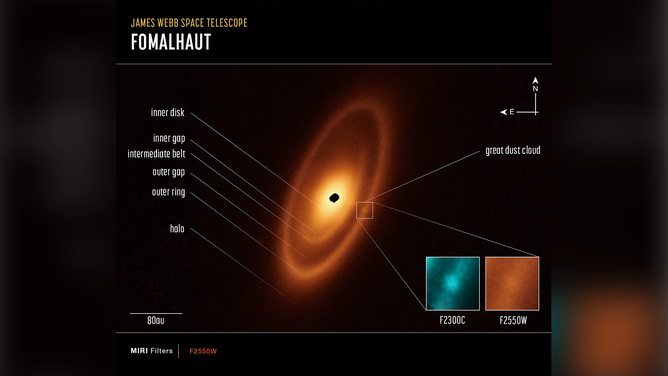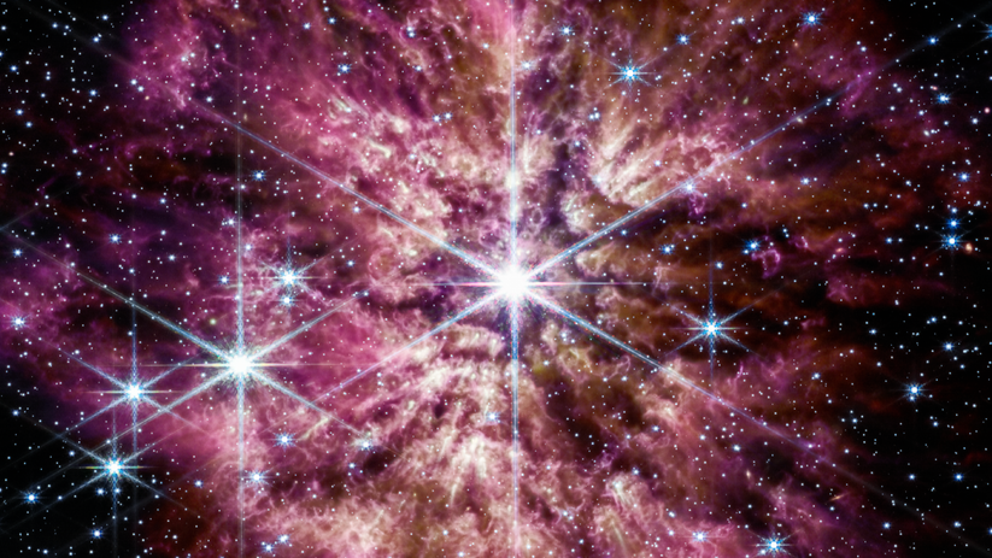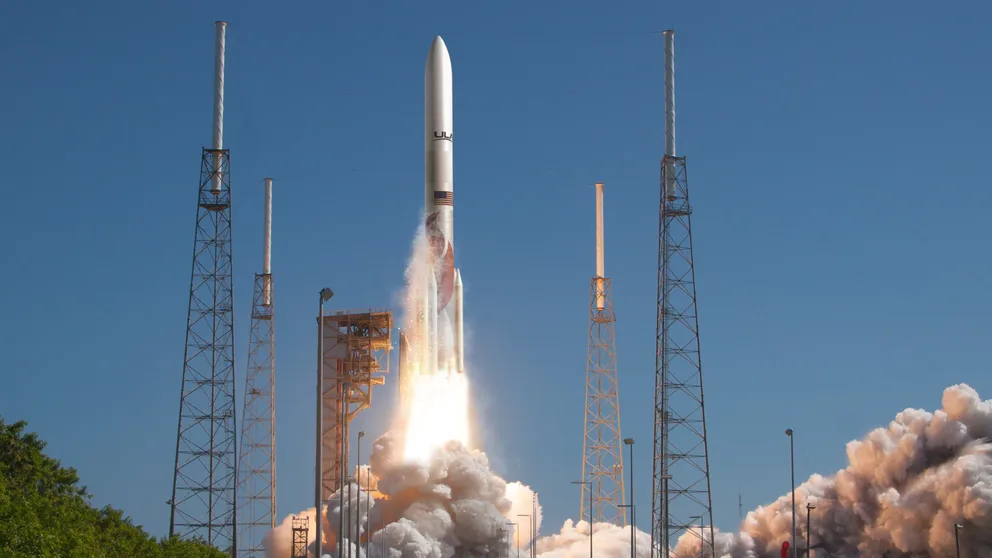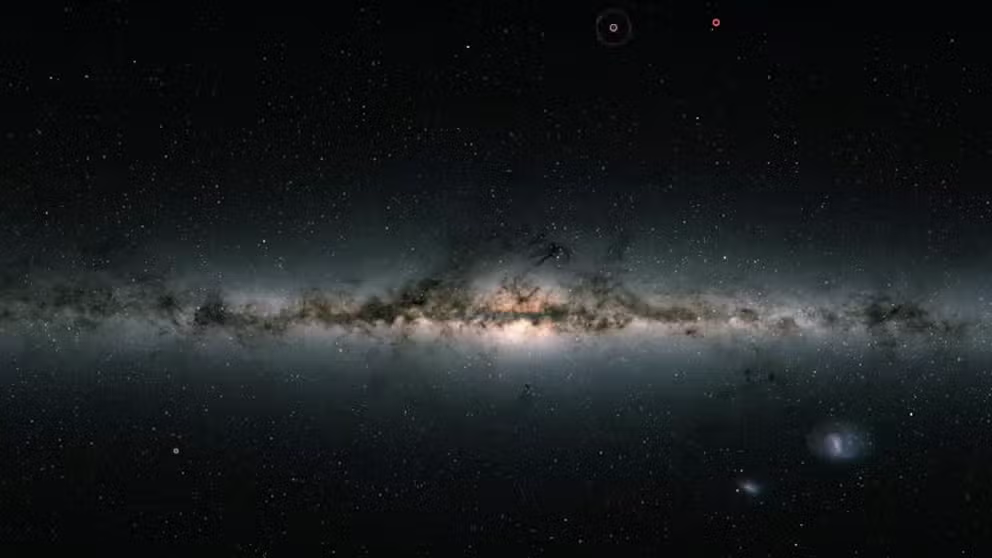James Webb Space Telescope provides stunning look of inner debris belts around nearby star for first time
NASA says there are actually three belts surrounding the star Fomalhaut that extend a whopping 14 billion miles, or about 150 times the distance of Earth from the sun.

This image of the dusty debris disk surrounding the young star Fomalhaut is from Webb’s Mid-Infrared Instrument (MIRI). It reveals three nested belts extending out to 14 billion miles (23 billion kilometers) from the star. The inner belts were revealed by Webb for the first time.
(NASA, ESA, CSA, A. Gáspár (University of Arizona). Image processing: A. Pagan (STScI) / NASA)
Astronomers using NASA’s James Webb Space Telescope to photograph a nearby young star, Fomalhaut, to study the first asteroid belt ever seen outside our solar system got much more than they bargained for.
According to NASA’s Jet Propulsion Laboratory, the dusty structures are much more complex than the asteroid and Kuiper dust belts in our solar system than previously thought.
Rarely seen prelude to supernova captured by James Webb Space Telescope
The luminous, hot star Wolf-Rayet 124 (WR 124) is prominent at the center of the James Webb Space Telescope’s composite image combining near-infrared and mid-infrared wavelengths of light from Webb’s Near-Infrared Camera and Mid-Infrared Instrument.
NASA says three belts are extending a whopping 14 billion miles from Fomalhaut, or about 150 times the distance of Earth from the sun.
In addition, the scale of the outermost belt is about twice the scale of our solar system’s Kuiper Belt of small bodies and cold dust found beyond Neptune.
The inner belts, which have never been seen before, were revealed in an image from the James Webb Space Telescope for the first time.
ARE BLACK HOLES DANGEROUS TO US?
A preview of the best space exploration moments to watch for in 2023
Here are the top space exploration milestones you can look forward to in 2023, including new rockets, moon missions, astronaut launches and many more planetary and Earth science objectives.
Fomalhaut, which NASA says is a "young" star, can actually be seen with the naked eye here on Earth as the brightest star in the southern constellation Piscis Austrinus.
The three dusty belts surrounding Fomalhaut are debris from collisions of larger bodies analogous to asteroids and comets. They’re frequently described as "debris disks," according to NASA.
"I would describe Fomalhaut as the archetype of debris disks found elsewhere in our galaxy because it has components similar to those we have in our own planetary system," said András Gáspár of the University of Arizona in Tucson and lead author of a new paper describing these results.
Gáspár added that looking at the patterns in the rings could show what a planetary system should look like if photos could show details deep enough to see the suspected planets.
NASA DEVELOPING A SNAKE-LIKE ROBOT TO SLITHER OVER ONE OF SATURN'S 83 MOONS

This labeled image of the debris disk surrounding the young star Fomalhaut shows the location of the three rings and other features. At right, a great dust cloud is highlighted and pullouts show it in two wavelengths of infrared light: 23 and 25.5 microns.
(NASA, ESA, CSA, A. Gáspár (University of Arizona). Image processing: A. Pagan (STScI) / NASA)
Previously, the Hubble Space Telescope and Herschel Space Observatory, as well as the Atacama Large Millimeter/submillimeter Array (ALMA), have all produced sharp images of the outermost belt, but none of them were able to find structures within it.
The inner belts have now been resolved for the first time by the James Webb Space Telescope in infrared light.
"Where Webb really excels is that we’re able to physically resolve the thermal glow from dust in those inner regions. So you can see inner belts that we could never see before," said Schuyler Wolff, another team member at the University of Arizona.
Now, Hubble, ALMA and the James Webb Space Telescope are tag-teaming to assemble a new view of the debris disks around several stars.
SCIENTISTS DISCOVER STAR DEVOURING PLANET FOR FIRST TIME AND THINK EARTH COULD SUFFER SAME FATE
Listen to the sounds of 5,000 exoplanets
In this animation, exoplanets are represented by musical notes played across decades of discovery. The lower the note, the longer the orbit, NASA says. (NASA/JPL-Caltech/M. Russo, A. Santaguida)
"With Hubble and ALMA, we were able to image a bunch of Kuiper Belt analogs, and we’ve learned loads about how outer disks form and evolve," said Wolff. "But we need Webb to allow us to image a dozen or so asteroid belts elsewhere. We can learn just as much about the inner warm regions of these disks as Hubble and ALMA taught us about the colder outer regions."
NASA says gravitational forces produced by unseen planets likely carved the belts. And as the James Webb Space Telescope photographs more systems, astronomers will learn more about the configurations of their planets.
"The belts around Fomalhaut are kind of a mystery novel: Where are the planets?" said George Rieke, another team member and U.S. science lead for Webb’s Mid-Infrared Instrument (MIRI), which made these observations. "I think it’s not a very big leap to say there’s probably a really interesting planetary system around the star."


